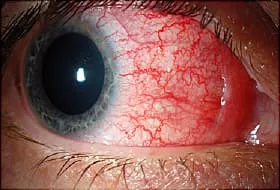The white part of your eye (called the sclera) is a layer of tissue that protects the rest of your eye. When this area is inflamed and hurts, doctors call that condition scleritis.
There isn’t always an obvious reason it happens, but most of the time, it’s caused by an autoimmune disorder (when your body’s defense system attacks its own tissues). Some of those that are linked to scleritis include:
- Rheumatoid arthritis
- Lupus
- Sjogren’s syndrome
- Scleroderma
- Wegener’s granuloma
- Inflammatory bowel disease
It also can be caused by an eye infection, an injury to your eye, or a fungus or parasite.
If it’s not treated, scleritis can lead to serious problems, like vision loss. It also can be linked to issues with your blood vessels (known as vascular disease).
Symptoms

- Anterior: This is when the front of your sclera is inflamed. It’s the most common type of scleritis.
- Posterior: This is when the back of your sclera is inflamed. It’s less common but can lead to serious eye problems like a detached retina or glaucoma.
Both anterior and posterior scleritis tend to cause eye pain that can feel like a deep, severe ache. You also might feel tenderness in your eye, along with pain that goes from your eye to your jaw, face, or head. And you may have blurry vision, unexplained tears, or notice that your eyes are especially sensitive to light.
Anterior scleritis also may make the white of your eye look red, and you may see small bumps there. With posterior scleritis, you can’t usually see these kinds of issues because they’re on the back of the white of your eye.
Diagnosis
If your eye hurts, see your eye doctor right away. They’ll look closely at the inside and outside of your eye with a special lamp that shines a beam of light into your eye.
They may refer you to a specialist or work with your primary care doctor to use blood tests or imaging tests to check for other problems that might be related to scleritis. Because it’s usually related to autoimmune disorders, your doctor may suggest that you see a rheumatologist (a doctor who specializes in autoimmune conditions).
Treatment
For very mild cases of scleritis, an over-the-counter non-steroidal anti-inflammatory drug (NSAID) like ibuprofen may be enough to ease your eye inflammation and pain.
Most of the time, though, a prescription medication called a corticosteroid is needed to treat the inflammation. It also can help with eye pain and may help protect your vision.
It’s rare, but if the sclera is torn or in danger of tearing, surgery may be needed to reinforce it. That’s called a scleral graft.
If an autoimmune disorder is causing your scleritis, your doctor may give you medicine that slows down your immune system or treats that disorder in another way.

